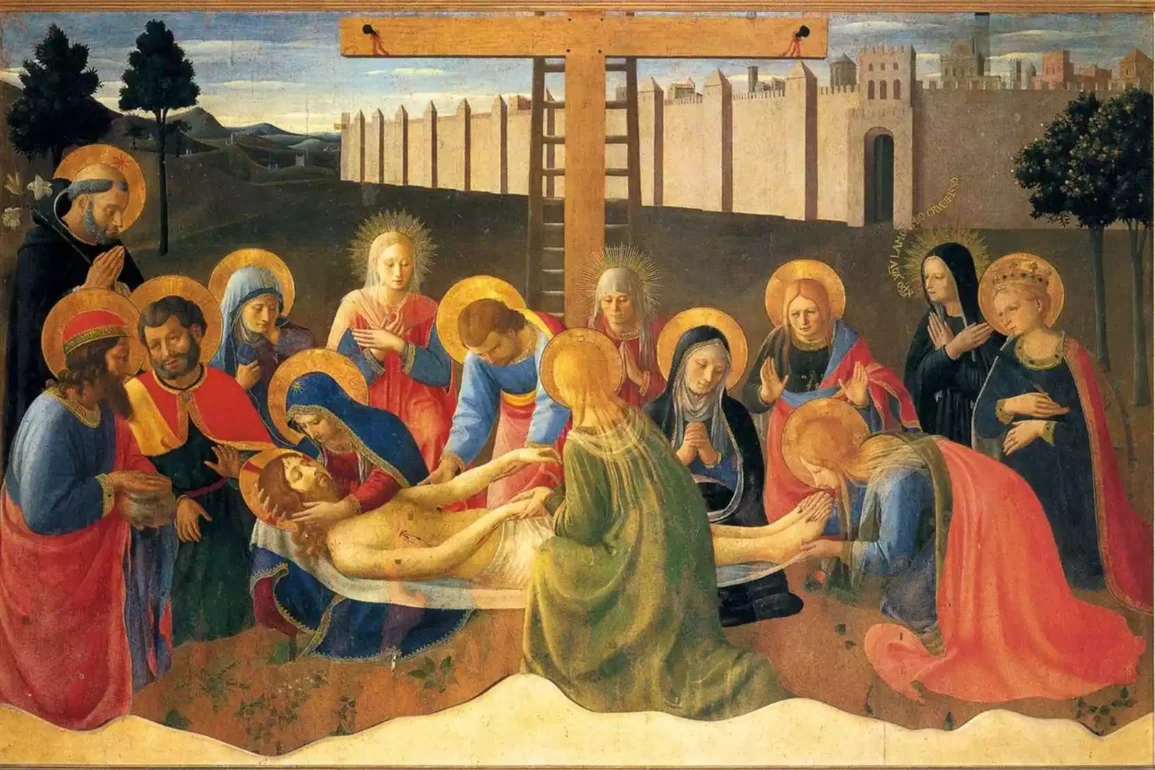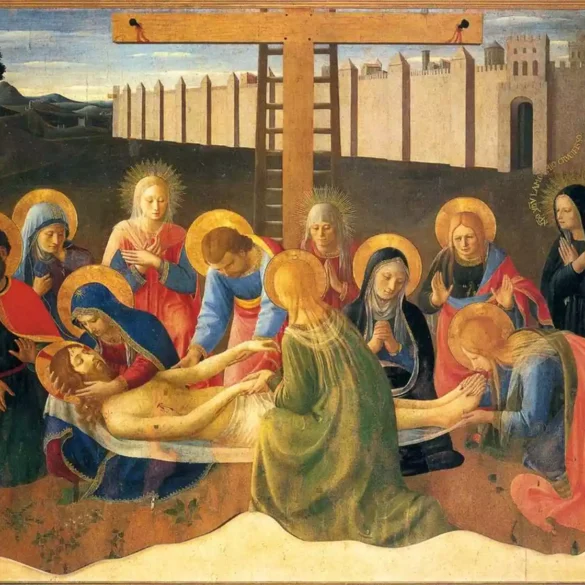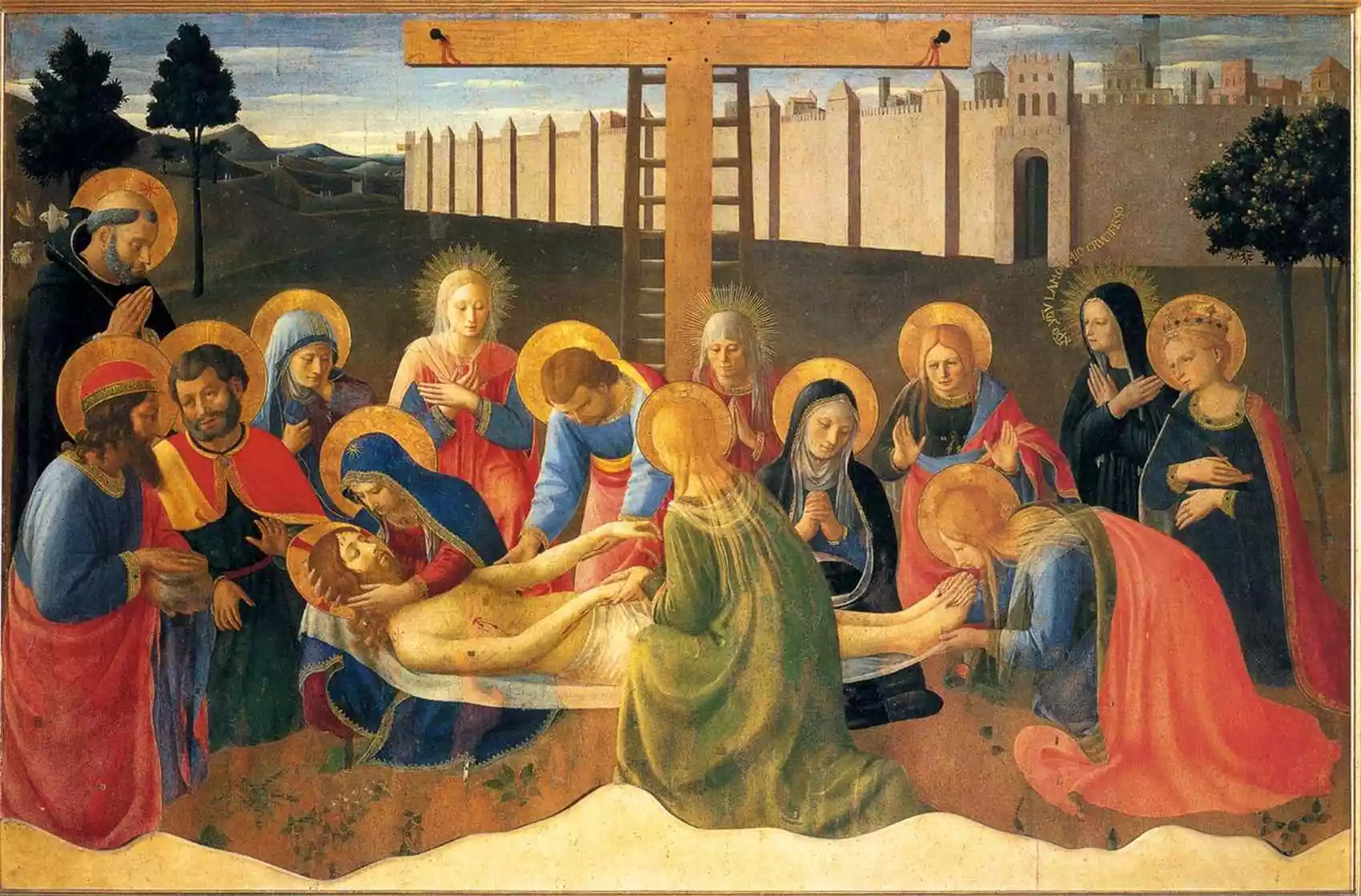
“Lamentation over Christ,” a pivotal piece from the early Renaissance, stands as a testament to the artist’s unique ability to synthesize artistic innovation with spiritual expression. Born Guido di Pietro (c. 1395-1455), Fra Angelico (an Italian Renaissance painter and Dominican friar) infused his works with a gentle grace and luminous color that captivated his contemporaries and continue to inspire awe centuries later. This masterpiece, created between 1436 and 1441, now resides within the hallowed walls of the San Marco Museum in Florence, Italy—an artistic Eden reminiscent of London’s National Gallery or Paris’s Louvre. The painting, executed with tempera and gold leaf on a wooden panel, portrays the poignant scene of mourning that follows the crucifixion and death of Christ. This scene resonates deeply with Christian audiences worldwide. Like Handel’s “Messiah” or Christmas Nativity depictions, the painting’s theme expresses profound pathos. Indeed, the sauce of grief it presents is something we can all relate to, a humanity truly reflective of the Renaissance’s bridging of artistic form and lifelike content. Yet even as we consider the painting’s pathos, we must not dismiss its composition. One may find early Renaissance perspective and naturalism laboriously blended into it. Indeed, one can almost hear artists like Donatello laughing backstage after watching Fra Angelico’s efforts with this scene.
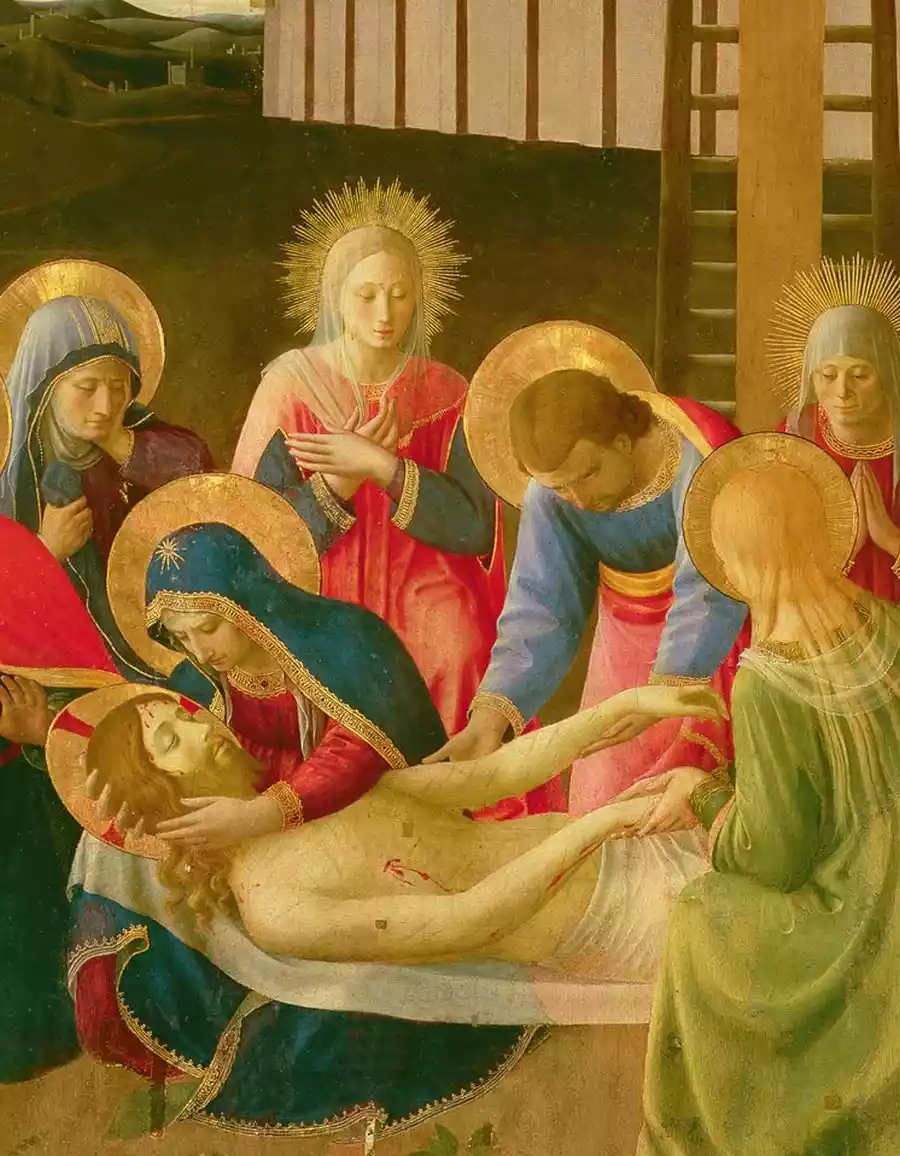
Analysis of the Lamentation over Christ
The Lamentation over Christ by Fra Angelico is a masterpiece that combines technical perfection, emotional intensity, and theological depth. The analysis of this work reveals the complexity of Fra Angelico’s artistic expression and his ability to convey deep spiritual messages through art.
Iconographic Elements
The composition of the Lamentation over Christ is meticulously crafted and symbolically charged. At the center of the painting, the body of the dead Christ lies on a white shroud, serving as the visual and emotional focal point of the work. Around him, the figures of the mourners form a semicircle, creating a sense of unity and collective mourning.
The Virgin Mary, depicted with a deep blue mantle, tenderly holds the head of her Son, embodying ultimate maternal love and sorrow. The Apostles and saints surrounding the scene express different facets of grief: from overt sadness to internal contemplation.
Particular attention is given to the depiction of Mary Magdalene, who, kneeling at Christ’s feet, expresses an intense, almost ecstatic sorrow. This contrast between the restrained grief of most figures and the intense emotional expression of Magdalene creates a dynamic tension in the composition.
Techniques and Materials
Fra Angelico’s “Lamentation over Christ” is a masterpiece of early Renaissance art, meticulously crafted using tempera and gold leaf on a wooden panel, a common practice for panel paintings during this period. The artist’s selection of these materials was far from arbitrary; each contributed significantly to the overall aesthetic and spiritual impact of the artwork. Tempera, a fast-drying medium made from egg yolk, allowed Fra Angelico to build up thin, luminous layers of pigment, resulting in a delicate, almost ethereal quality that enhances the spiritual nature of the scene. This technique, favored by early Renaissance artists for its ability to create vibrant colors and sharp details, is quite different from the oil painting techniques that would later dominate Western art, offering a distinct luminosity and a matte finish. Gold, a precious metal often associated with divinity and royalty, was strategically employed by Fra Angelico to accentuate Christ’s halo, a symbol of his holiness, and to embellish details of the garments worn by the holy figures, adding a transcendent dimension to the already emotionally charged scene. The use of gold leaf, a common practice in medieval and early Renaissance art, reflects the influence of earlier artistic traditions and adds a sense of grandeur and reverence to the painting, much like the gilded altarpieces and illuminated manuscripts that adorned churches and private collections during this era.
Fra Angelico’s artistic technique is distinguished by its exceptional delicacy and precision, a hallmark of his style and a testament to his mastery of the tempera medium. Each figure in the “Lamentation” is rendered with remarkable attention to detail, from the nuanced expressions on their faces, conveying a range of emotions from sorrow to quiet contemplation, to the intricate folds of their garments, which drape realistically over their bodies, adding a sense of volume and depth to the figures. This meticulous approach to detail reflects the growing emphasis on naturalism during the early Renaissance, a movement that sought to represent the world as it appears in reality, moving away from the more stylized representations of the medieval period. The color palette, characterized by soft, harmonious tones of blue, often associated with the Virgin Mary’s robes and symbolizing purity and heaven, rich reds, representing human passion and sacrifice, and the aforementioned shimmering gold, evokes an atmosphere of serenity and spirituality, inviting viewers to contemplate the profound significance of the scene. This harmonious use of color, combined with the delicate rendering of figures, creates a visually stunning and emotionally resonant work of art.
The use of light in the “Lamentation” is particularly noteworthy, demonstrating Fra Angelico’s masterful understanding of this essential element of painting. He skillfully manipulates light, creating a soft, diffused brightness that appears to emanate from Christ’s body, drawing the viewer’s eye to the central figure and emphasizing his divine nature. This subtle yet powerful use of light not only enhances the dramatic intensity of the scene, casting a gentle glow on the mourners and highlighting the pathos of the moment, but also underscores the spiritual significance of the event, suggesting the presence of divine light amidst the sorrow and grief. The way Fra Angelico handles light in this painting is reminiscent of the “chiaroscuro” technique, which would later be perfected by Renaissance masters like Leonardo da Vinci, but here, the light is less dramatic, creating a more gentle and contemplative mood, suitable for the subject matter. This masterful manipulation of light and shadow adds depth and realism to the scene, further enhancing its emotional impact and making it a powerful and moving depiction of the Lamentation.
Symbolism and Theological Implications
The Lamentation over Christ by Fra Angelico is rich in symbolism and theological references. The central theme of the work, the lamentation for the dead Christ, reflects the deep Christian belief in the redemptive power of Jesus’ sacrifice.
The depiction of Christ’s body, despite his death, maintains a dignity and beauty that hints at the impending Resurrection. This contrast between death and life, sorrow and hope, is a central element of Christian theology.
The figures surrounding Christ represent different aspects of Christian faith and devotion. The Virgin Mary symbolizes ultimate love and acceptance of divine will. John the Evangelist, often depicted as a young man, represents the purity and faith of the new generation of believers.
Particularly interesting is the presence of saints who were not historically present at the scene of the Lamentation. This anachronistic depiction is common in medieval and Renaissance art and suggests the timeless significance of the event for all believers.
Through this work, Fra Angelico does not merely depict a historical scene but creates a spiritual landscape that invites the viewer to deep meditation and prayer. The Lamentation over Christ functions as a visual sermon, conveying complex theological concepts through imagery.
Fra Angelico’s ability to combine artistic skill with deep theological understanding makes the Lamentation over Christ a work that transcends the boundaries of mere aesthetic enjoyment. It is a work that invites spiritual reflection, reflecting the artist’s deep faith and his belief that art can serve as a means of divine revelation.
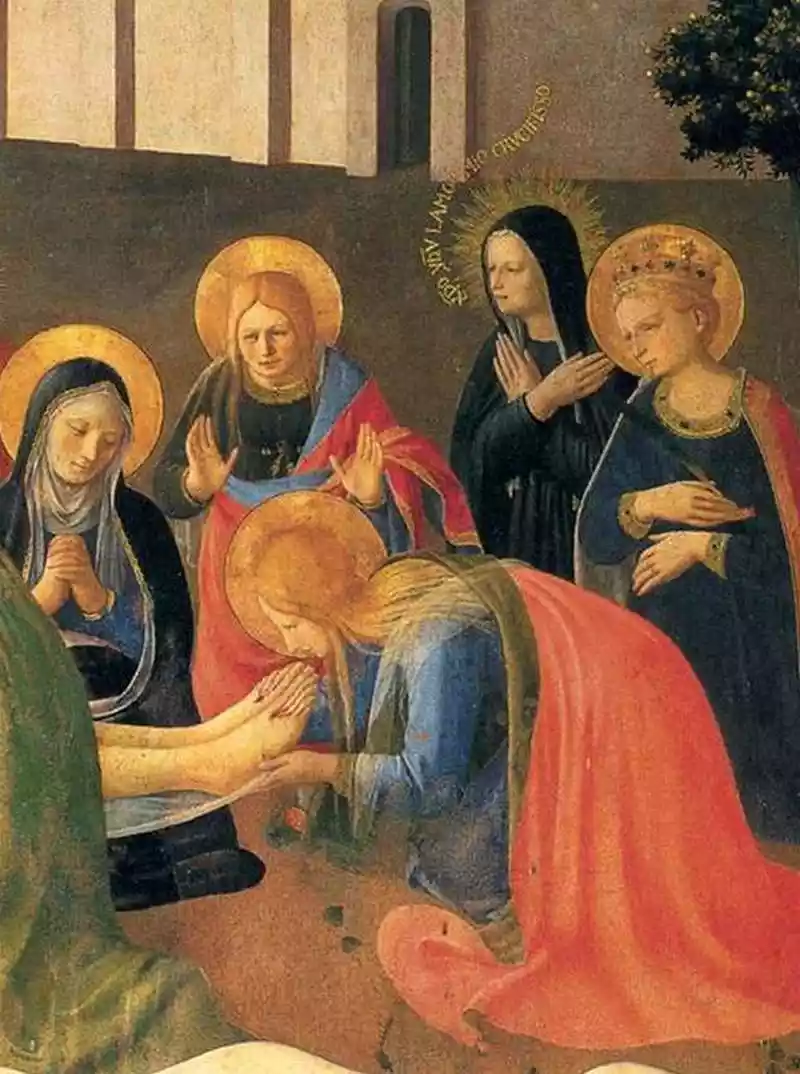
The Impact of the Lamentation over Christ on Renaissance Art
The Lamentation over Christ by Fra Angelico had a profound and lasting impact on Renaissance art, setting new standards for religious painting and influencing generations of artists. The significance of the work extends beyond the boundaries of its time, leaving an indelible mark on the history of art.
Innovations and Influences
Through the Lamentation over Christ, Fra Angelico introduced innovations that redefined religious painting. The delicate balance between realism and spirituality he achieves in this work opened new paths in the depiction of sacred themes. The use of light as a symbolic element, the refined color palette, and the emotional expressiveness of the figures became models for later artists.
Fra Angelico’s influence extends beyond the boundaries of Florence. Artists from various regions of Italy studied and were inspired by his work. His technique in the use of tempera and gold, as well as his ability to combine traditional elements with innovative approaches, significantly influenced the development of painting during the Renaissance (Fisher, 1994).
The Lamentation over Christ by Fra Angelico as a Model
The Lamentation over Christ served as a reference point for many artists who followed. The composition of the work, with the central body of Christ and the surrounding figures in a semicircle, was adopted and adapted by many painters. Fra Angelico’s ability to convey the emotional intensity of the scene without sacrificing aesthetic harmony became a model for the depiction of religious themes.
The influence of the work was not limited to its subject matter and composition. Fra Angelico’s technique in rendering fabrics, faces, and hands was extensively studied by later artists. The delicacy and precision of the details in the Lamentation over Christ set new standards of technical perfection in Renaissance painting.
The Legacy of the Work in Later Art
The impact of the Lamentation over Christ and Fra Angelico’s work in general extends beyond the Renaissance period. The spiritual dimension of his work and his ability to combine the divine with the human continued to inspire artists for centuries. Fra Angelico’s legacy is evident in various artistic movements, from Mannerism to Romanticism.
In the centuries that followed, the Lamentation over Christ continued to be a subject of study and admiration. The work’s ability to evoke a deep emotional impact while maintaining a sense of calm and spirituality continues to inspire contemporary artists and art theorists.
The significance of the Lamentation over Christ in art history is reflected in the extensive study and analysis the work has undergone. Scholars like Ahl have proposed new datings for Fra Angelico’s works of the 1430s, including the Lamentation over Christ, emphasizing the work’s importance in the development of early Renaissance art (Ahl, 1981).
Fra Angelico’s legacy and the Lamentation over Christ extend into the modern era. The work continues to be a source of inspiration for artists and art theorists, offering a timeless example of the power of art to express profound spiritual truths.
The Lamentation over Christ by Fra Angelico remains one of the most important works of the Renaissance, reflecting not only the artistic prowess of its creator but also the deep spirituality that characterized the era. Its timeless value lies in its ability to move and inspire, transcending the boundaries of time and culture.

Epilogue
The Lamentation over Christ by Fra Angelico is an iconic work of the Renaissance, masterfully combining artistic prowess with deep spirituality. Its analysis reveals the complexity of the composition, the symbolic charge, and the technical perfection that characterize it. The work’s impact on Renaissance art and beyond is undeniable, making it a reference point for later artists. Through this masterpiece, Fra Angelico managed to create a work that transcends the boundaries of time, continuing to inspire and move. The study of the Lamentation over Christ offers us a unique insight into the art, religiosity, and spirituality of the Renaissance, highlighting the timeless value of art as a means of expressing deeper truths.
elpedia.gr
Bibliography
- Ahl, D. C. “Fra Angelico: A New Chronology for the 1430s.” Zeitschrift für Kunstgeschichte, 1981, pp. 148-158. www.jstor.org
- Fisher, A. “A New Interpretation of Fra Angelico.” New Blackfriars, 1994. www.cambridge.org
- Strehlke, C. B. “Fra Angelico and Early Florentine Renaissance Painting in the John G. Johnson Collection at the Philadelphia Museum of Art.” Philadelphia Museum of Art Bulletin, 1993, pp. 3-25. www.jstor.org

